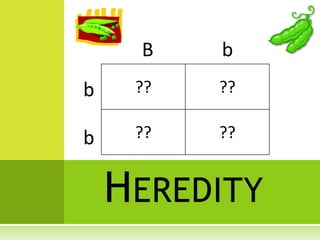
Heredity
- 1. B b ?? ?? b ?? ?? b HEREDITY
- 2. HEREDITY Passing of traits from parents to offspring Trait: distinguishing quality Why then don’t you look exactly like your parents? About 150 years ago Gregor Mendel performed some experiments that began to help us find the answers
- 3. GREGOR MENDEL Born 1822 in Austria Grew up on his family’s farm where he learned to grow flowers and fruit trees Went to a monastery where he worked in the garden Interested in how traits are passed from parents to offspring
- 4. GREGOR MENDEL Sometimes a trait that appeared in one generation did not show up in any of the offspring in the next generation. In the 3rd generation, the trait showed back up. Mendel noticed similar patterns in people, plants, and many other living things. He chose to study garden pea plants.
- 5. SELF-POLLINATING PLANTS Garden peas were a good choice because They grow quickly Usually self-pollinating Come in many varieties Self-pollinating: contains both male and female reproductive structures
- 6. TRUE-BREEDING PLANTS Mendel chose to study only one characteristic, like plant height or pea color, at a time He made sure to use true-breeding plants When true-breeding plants self-pollinate they always produce offspring with the same trait the parent plant has.
- 7. CROSS-POLLINATION Mendel wanted to see what would happen if he crossed two plants that had different forms of a trait To do this, he used cross-pollination. This method removes the male reproductive parts of a plant so that it can’t self-pollinate.
- 8. MENDEL’S FIRST EXPERIMENT Performed crosses to study 7 different characteristics Each cross was between the two traits of each characteristic
- 9. MENDEL’S FIRST EXPERIMENT •Mendel got similar results for each of the crosses that he made. •One trait always appeared and the other trait seemed to vanish.
- 10. TYPES TRAITS OF Dominant trait: observable trait when at least one dominant allele for a characteristic is inherited Recessive trait: trait that is observable only when two recessive alleles for the characteristic are inherited
- 11. SCIENTIFIC METHOD IN MENDEL’S WORK Ask a Question: How are traits inherited? Form a Hypothesis: Inheritance has a pattern. Test the Hypothesis: Cross true-breeding plants and offspring. Analyze the Results: Identify patterns in inherited traits. Draw Conclusions: Traits are inherited in predictable patterns.
- 12. MENDEL’S SECOND EXPERIMENT
- 13. MENDEL’S SECOND EXPERIMENT Mendel allowed the 1st generation to self- pollinate. This time the plant with the dominant trait for purple flowers was allowed to self-pollinate. As you can see, the recessive trait for white flowers show up again.
- 14. MENDEL’S SECOND EXPERIMENT Mendel decided calculate the ratios of dominant to recessive traits in each characteristic. Calculate the dominant-to- recessive ratio for each characteristic. Characteristic Dominant Recessive Ratio Flower color 705 purple 224 white 3.15:1 Seed color 6,002 yellow 2,001 green ___________ Seed shape 5,474 round 1,850 wrinkled ___________ Pod color 428 green 158 yellow ___________ Pod shape 882 smooth 299 bumpy ___________ Flower position 651 along stem 207 at tip ___________ Plant height 787 tall 277 short ___________
- 15. GENES ALLELES AND Mendel realized that his results could be explained only if each plant had two sets of instructions for each characteristic Each parent donates one set of instructions, genes, to the offspring. The fertilized egg would then have 2 forms of the same gene for every characteristic- one from each parent. The two forms of a gene are known as alleles.
- 16. PUNNETT SQUARES Used to visualize all possible combinations of alleles from parents. To make a Punnett Square, draw a square and then divide it into 4 sections. Next, write the letters that represent alleles from one parent along the top of the box. Write the letters that represent alleles from the other parent along the side of the box.
- 17. PUNNETT SQUARES Make a Punnett Square for a cross between a purebreed round seed plant(R) and a purebreed wrinkled seed plant(r). R R Rr Rr r Rr Rr r
- 18. GENOTYPES AND PHENOTYPES Dominant alleles are symbolized with capital letters. Recessive alleles are symbolized with lowercase letters. Genotype: Offspring’s inherited combination of alleles Phenotype: Organism’s appearance An organism’s phenotype is due to its genotype
- 19. ALLELES Heterozygous: having two alleles that are different for a given gene Homozygous: having identical alleles for a given gene